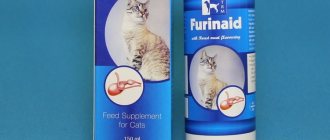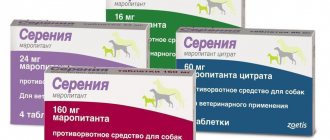5734Pavel
1
Many pet owners are wondering whether cats can be given Paracetamol. There can only be one answer here - you should never, under any circumstances, give this medicine to your pets. Paracetamol is poisonous for cats, as any veterinarian will confirm.
Animals should be treated by a specialist; self-medication can be fatal. Especially in cases where compassionate owners try to help their pets on their own, giving them medications from their own, “human” home medicine cabinet. Giving a cat Paracetamol means putting the animal in mortal danger.
© shutterstock
Content
1. General description 2. About medicinal properties and prohibitions 3. Poisoning and first aid 4. How to replace Paracetamol 5. Home remedies for reducing fever
When treating pets, medical (“human”) drugs are often used, so at the first sign of illness in a pet, owners often ask the veterinarian what medications can be given to alleviate the animal’s condition, and in particular, whether the cat can be given Paracetamol at a fever.
How does paracetamol affect a cat's body?
Paracetamol has a negative effect on the cat’s body, the following negative processes occur::
- Red blood cells decrease their ability to carry oxygen, and methemoglobinemia occurs. This leads to pathological oxygen starvation of the body.
- Accordingly, the load on the heart muscle increases significantly; it is forced to work in emergency mode, which is why cardiomyopathy develops.
- Paracetamol poisons the liver, causing irreversible tissue damage.
- The drug poisons the kidneys and their function is seriously impaired.
Therefore, it is impossible to lower a cat’s temperature with Paracetamol, it will only cause harm.
© shutterstock
About medicinal properties and prohibitions
Paracetamol is considered a vital and essential medicine, according to the World Health Organization. This is a widespread analgesic that is used for therapeutic purposes to treat fever, relieve headaches, dental and postoperative pain, joint pain, and in oncology to relieve pain.
However, not so long ago there was widespread information in the press that paracetamol has many dangerous side effects, in particular liver toxicity. There is also an assumption that paracetamol increases the risk of developing diseases of the gastrointestinal tract, in particular gastric bleeding. In this regard, doctors recommend carefully monitoring the dosage of drugs containing paracetamol, and veterinarians unanimously say: paracetamol is strictly prohibited for cats!
Even if in humans it can cause liver damage, even death (statistics say that almost half of cases of liver failure are associated with an overdose of paracetamol), then in pets the liver is generally unable to break down and remove acetaminophen from the body, which causes intoxication of the body and the death of the animal .
Paracetamol (acetaminophen) is included in many medications, and all of them are prohibited for veterinary use. Such medications include:
- Paracetamol;
- Panadol;
- Efferalgan;
- Anvi-Max;
- Askofen;
- Ibuklin and others.
In small doses, paracetamol is not dangerous for humans, so these drugs are widely used in the treatment of colds and fever, but cats should not be given such medications, even in case of emergency.
A single toxic dose for cats is 50-100 mg/kg (1 tablet may contain 200 or 500 mg of paracetamol). However, intoxication of the body can occur with a much smaller dose. In veterinary practice, there have been cases of death of animals at a dose of 10 mg/kg.
Poisoning dogs with paracetamol
Therefore, we must insist that the veterinarian be the only person responsible for prescribing our dog's medications. As we said, he will decide whether our dogs can take paracetamol. If we give paracetamol to our dog ourselves, we risk poisoning it, which can have fatal consequences.
Symptoms of paracetamol poisoning in a dog are as follows:
- vomit
- weakness
- abdominal pain
- salivation
- anorexia
- depression
- difficulty breathing
If we observe these symptoms and when we give the dog paracetamol or think that he may have accidentally become infected, we should contact the veterinarian, informing him of what has been done. The biggest problem with paracetamol in dogs is liver damage
. Hemolysis, a process that involves the accelerated destruction of red blood cells, may also occur. The bile and hemoglobin that comes from this breakdown accumulate in the body, causing a yellowish color in the mucous membranes (jaundice) and excretion of brown urine due to the content in the hemoglobin.
Depending on the circumstances, the veterinarian will decide the most appropriate treatment, which may include vomiting, fluid therapy, or even a blood transfusion. In the most serious cases, the dog may die. This should make us think about the importance of never treating our dog ourselves.
Poisoning and first aid
After taking Paracetamol or other drugs containing acetaminophen, clinical signs of intoxication may appear within the first two to four hours.
Symptoms of paracetamol poisoning in cats:
- labored breathing;
- depressed state;
- vomit;
- swelling of the muzzle and limbs;
- yellowing of the skin;
- dark chocolate color of urine;
- change in the color of the gums and whites of the eyes - they acquire a bluish or yellowish tint.
Important!
If you notice these signs or suspect acetaminophen poisoning, you should contact your veterinarian immediately. The sooner treatment is started, the greater the chance of a favorable outcome.
The above symptoms indicate methemoglobinemia - an increased amount of methemoglobin (hemoglobin with ferric iron). It cannot bind oxygen and, accordingly, transport it to tissues. With methemoglobinemia, a cat can die within 18-36 hours. The pet can be saved only by urgently starting treatment. It will be lengthy and expensive, and the animal will require good care.
Precautions during treatment
We have seen that dogs can only take paracetamol under veterinary supervision, so to avoid accidents that could have fatal consequences, the following precautions are recommended:
- Never treat our dog unless it is under veterinary prescription.
- Always keep medications away from our dogs.
- When we are forced to treat them, we must do so by scrupulously following our veterinarian's instructions regarding the dose and duration of treatment.
- If we suspect that our dog may have ingested a large amount of paracetamol or we have given it, we must take it to the vet immediately.
This article is for informational purposes only, we are not in a position to prescribe veterinary procedures or make any diagnoses. We invite you to take your pet to the veterinarian if there are any conditions or discomfort.
How to replace Paracetamol
There are medications on the veterinary drug market with antipyretic and analgesic properties that are safe for pets. However, first of all, the cause of the increase in temperature must be established. Only a veterinarian can do this professionally, and at home you should leave the animal alone for a while, providing access to clean water. After half an hour or an hour, if the temperature has not dropped and there are signs that the animal is unwell, take the pet to the clinic or invite a specialist to your home.
Important!
A cat's body temperature above 41°C causes critical loss of fluid from the body and can provoke swelling of the brain and life-threatening damage to internal organs.
First aid:
- ensure peace and access to fresh water;
- in case of heat stroke or too high a temperature, you can moisten the animal’s fur with water;
- ensure the flow of fresh cool air into the room;
- if dehydration and lack of thirst (the cat refuses to drink), add water using a pipette or syringe without a needle.
Important!
Regidron will help restore water balance and alleviate the condition of a sick animal.
Among the medications that will help reduce your pet’s temperature and relieve pain, the most often chosen are drugs based on ketoprofen or meloxidil. Ketoprofen is a propionic acid derivative that has analgesic, antipyretic, and anti-inflammatory properties. Ketoprofen is included in the following veterinary drugs:
- Ainil - 1% solution is used subcutaneously for cats as an antipyretic, as well as to relieve pain of any etiology;
- Ketoprofen – 10% solution, has an antipyretic effect, relieves pain and inflammation;
- Flexoprofen is used to reduce body temperature in cats, as well as in the treatment of acute, subacute and chronic inflammatory diseases accompanied by pain.
The following veterinary drugs also have antipyretic and analgesic properties:
- Vetalgin;
- Ketoquin;
- Rimadyl and others.
Meloxicam is prescribed to cats for diseases of the musculoskeletal system, which are accompanied by severe pain and inflammation. The drug has anti-inflammatory, analgesic and antipyretic properties. An analogue of the drug is Meloxidil.
Why does a cat have a fever?
Normally, a cat's temperature is 38-39 degrees. Kittens have a slightly higher body temperature than adult cats. Body temperature also depends on the time of year - in summer it is higher. Sphynx cats have a high body temperature. Normally it is 41-42 degrees. In other cases, the temperature increase may be due to the following reasons.
- Simple, banal overheating. If a cat is forced to spend some time in the sun, its body temperature can rise above 41 degrees. This can happen if the cat is locked in a stuffy room or while the animal is being transported. In this case, you need to move the cat to a cool place and give it water. Usually the temperature stabilizes within a few hours.
- Sometimes cats encounter infectious diseases. If your pet, in addition to a high temperature, experiences vomiting, weakness, lack of appetite, and decreased urination, this is a serious reason to contact a veterinarian.
- Cats also get sick from viral diseases. In this case, you may experience tearing, mucus from the nose, and sneezing. In case of viral diseases, it is important to ensure high humidity in the room and give the cat enough to drink.
- High temperature may be a consequence of emotional shock. Often cats show anxiety after visiting exhibitions, the veterinarian, after moving or losing their owner. In this case, calm the animal and, if possible, bring the cat into its usual habitat. Stress fever usually goes away quickly once everything is back to normal.
- Often the body temperature rises due to the animal's physical activity. But this increase is insignificant - no more than 1 degree.
- Sometimes body temperature increases in pregnant cats due to physiological processes.
- Often, a high temperature in a cat is associated with oncology, so wondering about the diagnosis and procrastinating is a crime. Show the animal to the veterinarian and make sure there are no irreversible processes.
But sometimes it happens that the whole point is in the incorrect measurement of the animal’s body temperature.
Video: how to measure an animal's temperature
What medications should not be given to cats. Human medications are sometimes used to treat cats. If they were prescribed by a veterinarian, then they can be used, but there are medications that should never be given to cats. Each animal species has different chemical processes inside its body. Even different people react completely differently to medications. There are medications that are contraindicated or useless for one race of people, while for others, on the contrary, they are indicated and have a good effect on the body. It mainly depends on the blood type. The whole world consists of atoms and chemical processes. And we are no exception in this regard. Good doctors and pharmacists know what processes occur in a living organism from taking this or that drug, but even the best doctor cannot say without tests whether this medicine will help or, on the contrary, will kill a living organism.
The chemical processes in the body of cats are different from ours, so before giving medicine, you should consult a veterinarian. It is practicing veterinarians who know what can be given to cats and what cannot be given.
There are medications that can simply kill an animal or make it disabled. Therefore, every cat owner needs to know which medications should never be given to cats, and which ones can be used, but in limited quantities.
- Analgin (severe poisoning);
- Aspirin (can poison the animal to death);
- Antibiotics;
- Benzyl benzoate (dangerous even when applied externally, if it is simply present in ointments);
- Berenil;
- Biseptol;
- Veriben;
- Gentamicin;
- Ivermectin;
- Ketoprofen;
- Corticosteroids (Prednisolone, Dexamethasone, Dexafort);
- Levamisole (can cause severe poisoning);
- Vishnevsky ointment;
- Nise;
- Naphthalene (put it away from moths, but poison the cat);
- No-Shpa (can cause vomiting and paralysis of the hind limbs);
- Nurofen (Ibuprofen);
- Paracetamol (toxic to cats);
- Panadol (same reaction as paracetamol);
- Purosan;
- Rimadyl;
- Salicylates;
- Theraflu;
- Tylenol (same reaction as paracetamol);
- Phenol-containing drugs;
- Most non-steroidal and anti-inflammatory drugs;
- Sedatives and sleeping pills;
- Use medicines infused with plants with caution;
- Bleach (do not use it for disinfection);
If you keep animals at home, never leave medications in places accessible to them. Some cats may become attracted to the rustling packaging and swallow it. But my cat Kesha, despite the fact that many of the tablets are bitter, even manages to open the cupboard and chew them. Now we hide all the medicines under lock and key.
Also, do not keep poisonous plants at home. Sooner or later cats will probably try it. My friend’s old cat chewed on Echinbachia leaves and almost gave his soul to God. For many years he did not pay any attention to this flower, but in his old age he decided to feast on it. It’s good that the owner noticed the bitten leaves of the plant and quickly took the cat to the veterinarian.
What to do if you eat it?
Attention! If your dog accidentally swallows a paracetamol tablet, the first step is to immediately consult a veterinarian!
In case of poisoning, gastric lavage with water and activated charcoal are used; acetylcysteine is a specific antidote; S-adenosyl methionine can be used in the absence of acetylcysteine.
Ascorbic acid and methylene blue are also used to reduce methemoglobin and convert it into hemoglobin.











